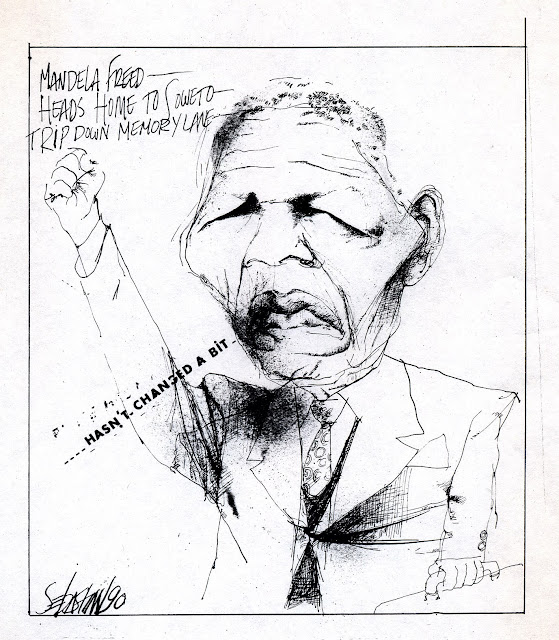{ RIP } ~ Nelson Mandela
Sadly, the world lost one of it's most admired individuals: Nelson Mandela.
I still remember watching the live television broadcast on the day of his release. This was one in a series of seismic changes in world affairs during this period. The fall of the Berlin Wall and the collapse of Communism being another. Looking back now, I realize how lucky I was to work during this remarkable period: to witness these events and to record my impressions of them and have them published.
With Mandela's release, it was clear that South Africa was never going to be the same again. The question was, once the euphoria of his release subsided, what would happen next and more importantly, would the 'settling of accounts' lead to violence? It was clear, Mandela would be instrumental in the transition, and his response was critical. The world was watching.
I remember being struck by the lack of drama in his demeanor. Other politicians, Thatcher comes to mind, Churchill, Clinton, etc. would have relished such moments for their historical importance and would have 'played to the cameras' projecting some image of the 'great leader'. Mandela, in contrast, treated it as if he had returned from a long visit abroad. He smiled broadly and warmly. His gestures were shy, almost awkward as if he was surprised at all the fuss. There was the raised fist on that day and in the short days that followed but that was quickly replaced with the open hand.
It was clear on that day that we were witnessing a remarkable individual who would not let past experiences and injustices cloud his judgement. Instead, he would be governed by 'the better angels'. The world breathed a huge sigh of relief. It was under Mandela's wise and noble leadership, those 'better angels', that South Africa opted for Truth And Reconciliation not vengeance and recrimination. Of course, given his past experience, only he could ask this of his people and only he could command that.
The concept for my illustration was born while watching those images on television. For big events such as these, you can fall prey to trying to create a 'very-important-cartoon' and look for symbols and allegories. Sometimes you can 'overreach' during some of these events and the image, in hindsight, looks 'overblown'. Not being South African, I didn't think it my place to do a 'history lesson' cartoon on Apartheid. Instead I focused more on the impressions I witnessed and, as noted above, I was surprised at how 'human' Mandela responded to this momentous occasion. It was very much like someone who had a homecoming and was surprised people showed up. That became the springboard for the image. I had him returning to his 'old stomping grounds' only to find 'things really hadn't changed much over time'. An ironic comment to be sure and one that hinted at the monumental task he had before him. Similarly, I had him a bit grim faced here to give the image the gravitas I thought it deserved versus a smiling face which might seem too frivolous.
This was done with pen and ink. I was inspired by the British cartoonists Searle, Scarfe, and Steadman - I liked their spontaneity of drawing versus the more labored approach practiced in North America. I loved how these artists were still able to draw accurately with great observation but draw with verve. Their pen work was always fluid, and their imagery was fresh and expressive. I used rubber cement to mask off certain areas and a toothbrush dipped in ink and flicked with a toothpick provided the spattered tones.




Comments
Post a Comment